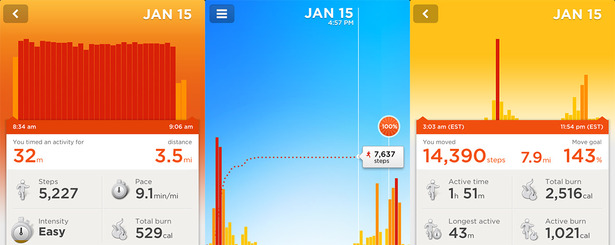The Secret to Losing Weight, According to My New High-Tech Fitness Monitor, Is (Wait for It ...) Walking
And it's backed up with new (scary) data on American walking habits.
It's been a few weeks since January 1, the day that Americans decide they need to lose a few pounds after the holiday season. I was ahead of the game and had decided I'd gotten fat by the first of December. So I've had a few more weeks than the rest of America to think about fitness.
During that time, I've been gathering data using the new fitness-tracking gadgets, the Fitbit One and the new Jawbone Up. I liked both products very much, but since I put the One through the washing machine and killed it, I've mostly been using the Up. If you're a data nerd, the Up also gives you a lot more to play with than the Fitbit.
My quick profile: I'm a big runner (probably 25-35 miles a week). I like hiking (1-2 good ones a week). We eat pretty healthily at home, but I also like ice cream and tortilla chips and beer. I telecommute.
The initial goal set on the Up device is 10,000 steps, which is about how much people walk in Australia and Switzerland but nearly double the American number (5,117). Because I run so much, I expected the Up to basically pat me on the back and tell me that I'd done a good job.
But here's the thing, if you sit all day (in a car, at work, on the couch), but head out for a quick 3.5-mile run, you're not actually getting much activity in.
Take my January 15. I popped out for a three-and-a-half-mile run in the morning, then sat around for the rest of the day. But the run got me a mere 5,227 steps, only halfway to the goal, as you can see on the left image. (My runner's pride would like to point out that I forgot to stop timing the activity for a couple of minutes, which is why my per-mile time is so slow.)
Then I had to head to go sit on a plane for five hours on the way to New York. My puttering around the airports had gotten me to 7,637 total steps at 5pm (middle image). It wasn't until I got to Manhattan and decided to explore the neighborhood for a while that I was able to meet, then exceed the step goal. By the end of the day, my workout only represented half of my total movement, yet -- subjectively -- it felt much more significant as an act of fitness than walking around Nolita.
I've noticed this trend time and again. I overestimate the value of my official "workouts" and underestimate the value of walking as a means to an end.
Americans lag behind the rest of the world in steps taken precisely because we travel so rarely for transportation's sake. Our cities are spread out (NYC excepted) and car culture is everywhere. A Centers for Disease Control study found that almost 40 percent of Americans had not walked for 10 straight minutes in the past week!
Even more interestingly, Gregg Furie of Yale Medical School led a study that showed that less than 25 percent or people walked or biked as a means to get from one place to another for more than 10 straight minutes in a given week. And yet, Furie's study found that people who engaged in "active transportation," as he calls it, had lower BMI, smaller waists, and lower odds of hypertension and diabetes.
The ways we've developed our country's infrastructure to deter walking and encourage driving are, as Slate put it, "a full-blown public health nightmare." Many places are not safe to walk, for one reason or another, and still more are unpleasant. In many areas, like the one I grew up in, the only place to walk within five miles would be a gas station. Furie, optimistically put it like this, "This information adds to the weight of evidence that suggests more work is necessary to develop environmental policies that make it safer, easier, and more desirable for people to walk and bike for transportation."
I'd note that one aspect most walking studies don't seem to cover is the time that it takes. When people are working long hours, it's hard to stomach the idea of spending an extra 30 minutes walking yourself home instead of hopping in the car. It's an underappreciated part of what Mother Jones calls "The Great Speedup": who has the time to walk?
And maybe that's what personal data is best for. In my own tiny data (n=1) way, I can see the benefits of walking, even if it feels like a hassle or a waste of time. The once-abstract good is made plain. Assuming my food intake remains roughly the same (which is a big assumption), walking is almost certainly the deciding factor in losing, gaining, or maintaining weight.
So, I love the data my fitness tracker provides, but if you want to skip the $130 purchase, I think I've gleaned the real lesson that matters: when you have the opportunity to walk as a means to an end, take it.
Alexis Madrigal is a contributing writer at The Atlantic and the host of KQED’s Forum.
